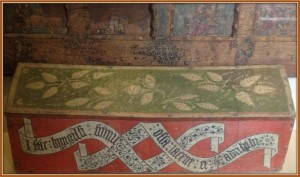Approximately a year ago, archeological researchers from Oxford discovered remains of one of Furness Abbey’s medieval abbots. Furness, founded in 1124 by King Stephen. Located in northern Cumbria, it was the second largest, wealthiest and obviously influential, abbey in the country prior to the dissolution rampage of King Henry VIII. The following is an excerpt of a report of the find filed by Fatima Manji with Britain’s Channel 4 News:
The skeleton was found by Oxford Archaeology North who were carrying out excavations during emergency repairs at the Cumbrian site. The rare find could date as far back as the 12th century. The abbot’s body was buried with a very rare medieval gilded crosier and jeweled ring. [According to] English Heritage curator Susan Harrison, “This is really significant because it’s the first time under modern conditions that an abbatial or abbot burial has been discovered intact with so much detail and information – from the skeleton to the mark of his office, his crosier, his ring, but also fragments of textile in there.”
Oxford Archaeology North’s Stephen Rowland[stated], “It’s extremely rare to find such a burial. Nationally he’s an important person; he’s a member of the Cistercian order which was the most powerful monastic order in England. He would have had estates across the Furness Peninsula, into Cambria, Lancashire and Yorkshire, control over large amounts of resources. He was a bit like a feudal overlord.”
The archaeologists are now carrying out carbon 14 dating to find out when the abbot actually died. The results of this could give them a 25 year window, which may help to identify which abbot he was. However, the window could be as much as 100 years either side of his actual death. Ms Harrison explained how the burial was found: “It was noted that the walls of the east end of the church were cracking and subsiding. A major investigation was set up by English Heritage to work out what was happening with these walls and then to try and reduce any impact on the ground. Archaeological work was undertaken to enable us to find out what was significant in the area that we were going to do further works on to stabilise the abbey ruins.”
Mr Rowland explained what they already know about the abbot. He said: “We think he’s about 40 to 50-years-old which we can tell from the wear on his teeth, the way the bones are fused together and the sutures on the skull and the aspects on the pelvis. He’s about 5’7 tall by measuring his leg bones and he would have been a very important person in the abbey.” He said the abbot probably suffered from arthritis and was most likely a portly man. He said: “He’s got a bony growth going down his vertebrae. It’s a condition called DISH, which is associated with obesity and middle-aged onset type-2 diabetes. So it’s quite probable that he was having a fairly rich diet. The abbot’s knees were also worn.” Mr Rowland added: “He could have been praying quite a bit on his knees. We’ve got arthritis around his platella on his knee cap – again this signifies more bony growth. He could have spent a bit of time on his knees writing and reading quite a lot, but he wasn’t hugely active like other medieval people of lower status really.”
Ms Harrison said the ring was probably a reminder of piety: “It tells us he was a man of status to wear a ring. It was found on one of the fingers of his right hand and what’s really interesting is that it’s a copper alloy but it’s been gilded and it’s got a point behind – can you imagine how uncomfortable it would have been to wear that? It’s possibly as a reminder of his piety, a reminder of his position and his oaths to god.”
The head of the crosier is made of gilded copper and decorated with gilded silver medallions showing the Archangel Michael defeating a dragon. The crosier’s crook or end is decorated with a serpent’s head. Ms Harrison added: “This abbot was obviously of high status because he was buried with a very nice crosier, rather than a wooden or a lead replica of that. It’s in good condition. The only damage is caused by corrosion in the ground.”

Mortuary Chests Such As This One in Winchester’s Cathedral Were Often Used To Hold Ecclesiastical Remains
Photography ©Gaye F. Mack, Inc.
You can follow me on:
https://www.facebook.com/gayemackauthor, https://gayemack.com, https://www.twitter.com/gayemack or https://www.linkedin.com

Furness is not in north Cumbria but in the south of the county. Up to several decades ago, it was in Lancashire.